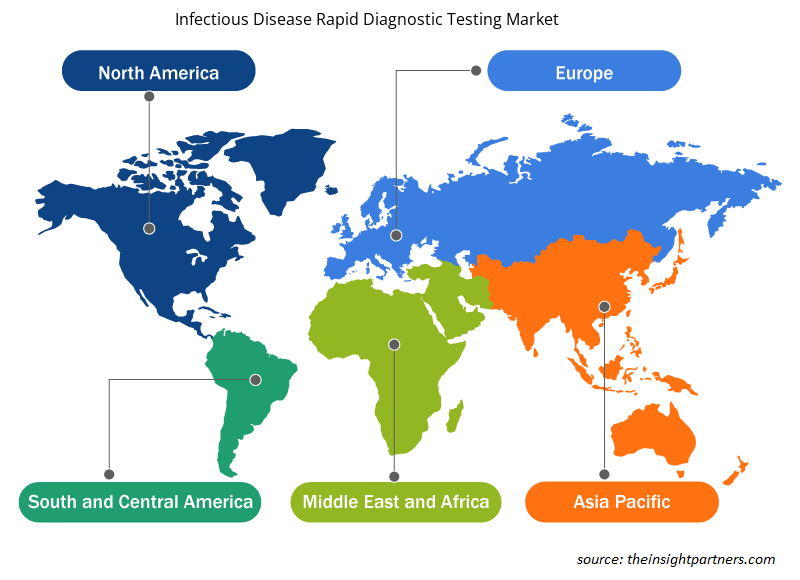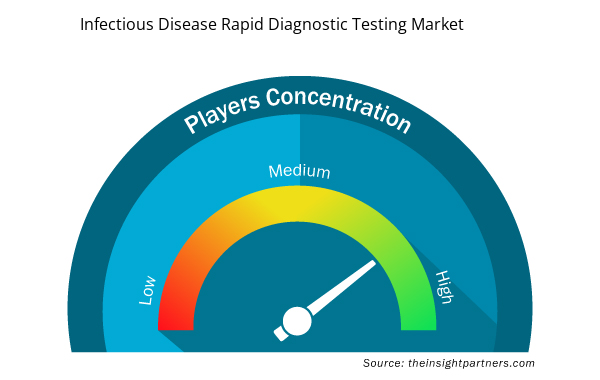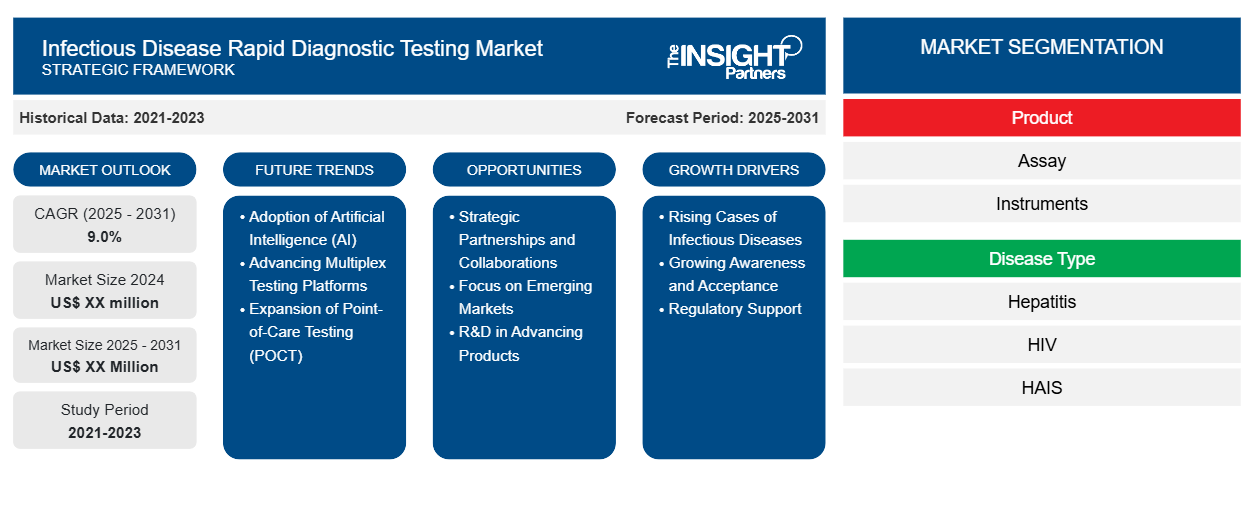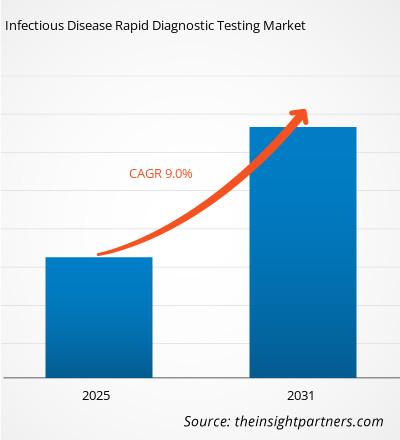من المتوقع أن يسجل سوق اختبار التشخيص السريع للأمراض المعدية معدل نمو سنوي مركب بنسبة 9.0٪ من عام 2023 إلى عام 2031، مع توسع حجم السوق من XX مليون دولار أمريكي في عام 2023 إلى XX مليون دولار أمريكي بحلول عام 2031.
يقدم التقرير تحليلاً يعتمد على المنتج (التحليل، الأدوات)، وحسب نوع المرض (التهاب الكبد، فيروس نقص المناعة البشرية، HAIS ، فيروس الورم الحليمي البشري، السل، الأنفلونزا، أمراض أخرى). يقدم التقرير تحليلاً يعتمد على التكنولوجيا ( التشخيص المناعي ، علم الأحياء الدقيقة السريرية، تفاعل البوليميراز المتسلسل ، INAAT ، وغيرها). يقدم التقرير أيضًا تحليلاً يعتمد على المستخدم (المستشفيات والعيادات والمختبرات التشخيصية وغيرها). يتم تقسيم التحليل العالمي بشكل أكبر على المستوى الإقليمي والدول الرئيسية. يتم تغطية حجم السوق والتوقعات على المستويات العالمية والإقليمية والقطرية لجميع قطاعات السوق الرئيسية ضمن النطاق. يقدم التقرير القيمة بالدولار الأمريكي للتحليل والقطاعات المذكورة أعلاه. يقدم التقرير إحصائيات رئيسية عن حالة السوق للاعبين الرئيسيين في السوق ويعرض اتجاهات السوق والفرص.
غرض التقرير
يهدف تقرير سوق الاختبارات التشخيصية السريعة للأمراض المعدية الصادر عن The Insight Partners إلى وصف المشهد الحالي والنمو المستقبلي وأهم العوامل الدافعة والتحديات والفرص. سيوفر هذا رؤى لمختلف أصحاب المصلحة في الأعمال التجارية، مثل:
- مزودي/مصنعي التكنولوجيا: لفهم ديناميكيات السوق المتطورة ومعرفة فرص النمو المحتملة، وتمكينهم من اتخاذ قرارات استراتيجية مستنيرة.
- المستثمرون: إجراء تحليل شامل للاتجاهات فيما يتعلق بمعدل نمو السوق، وتوقعات السوق المالية، والفرص المتاحة عبر سلسلة القيمة.
- الهيئات التنظيمية: لتنظيم السياسات ومراقبة الأنشطة في السوق بهدف تقليل الانتهاكات والحفاظ على ثقة المستثمرين والحفاظ على سلامة السوق واستقرارها.
تجزئة سوق اختبارات التشخيص السريع للأمراض المعدية
منتج
- فحص
- الآلات الموسيقية
نوع المرض
- التهاب الكبد
- فيروس العوز المناعي البشري
- هايس
- فيروس الورم الحليمي البشري
- السل
- الانفلونزا
- أمراض أخرى
تكنولوجيا
- التشخيص المناعي
- علم الأحياء الدقيقة السريرية
- تفاعل البوليميراز المتسلسل
- إنات
- آحرون
المستخدم النهائي
- المستشفيات
- العيادات
- المختبرات التشخيصية
- آحرون
المستخدم النهائي
- المستشفيات
- العيادات
- المختبرات التشخيصية
- آحرون
قم بتخصيص هذا التقرير ليناسب متطلباتك
ستحصل على تخصيص لأي تقرير - مجانًا - بما في ذلك أجزاء من هذا التقرير، أو تحليل على مستوى الدولة، وحزمة بيانات Excel، بالإضافة إلى الاستفادة من العروض والخصومات الرائعة للشركات الناشئة والجامعات
- احصل على أهم اتجاهات السوق الرئيسية لهذا التقرير.ستتضمن هذه العينة المجانية تحليلاً للبيانات، بدءًا من اتجاهات السوق وحتى التقديرات والتوقعات.
محركات نمو سوق الاختبارات التشخيصية السريعة للأمراض المعدية
- ارتفاع حالات الإصابة بالأمراض المعدية: تضع الحكومات ومنظمات الصحة التشخيص السريع على رأس أولوياتها لتحسين طريقة رصد الأمراض والاستجابة لها. ومع تزايد شيوع الأمراض المعدية، ستستمر الحاجة إلى حلول الاختبار السريع في النمو. وهذا من شأنه أن يخلق فرصًا مربحة للشركات في السوق.
- زيادة الوعي والقبول: لقد عملت الحملات الصحية العامة والمبادرات التعليمية على تثقيف الناس حول الأعراض وطرق انتقال المرض، ويتخذ الناس نهجًا استباقيًا في إجراء الاختبارات. وقد أثبت قبول الاختبارات السريعة، خاصة أثناء تفشي الأمراض مثل كوفيد-19، قيمتها في إدارة أزمة الصحة العامة. ويدرك العاملون في مجال الرعاية الصحية والمرضى مدى ملاءمة وسرعة الاختبارات السريعة، وبالتالي يتزايد اعتمادها.
- الدعم التنظيمي: يعد التمويل من الحكومات والمنظمات الصحية من المحركات الرئيسية في سوق الاختبارات التشخيصية السريعة للأمراض المعدية. تعمل السلطات على تبسيط عملية الموافقة على التقنيات التشخيصية الجديدة حتى تتمكن من الوصول إلى السوق بشكل أسرع. تركز مبادرات مثل أجندة الأمن الصحي العالمي (GHSA) على تحسين القدرات التشخيصية عالميًا وخلق بيئة مواتية للابتكار. تمكن هذه البيئة التنظيمية الداعمة بالتمويل الشركات من تطوير وتسويق حلول التشخيص المتقدمة ودفع نمو السوق.
الاتجاهات المستقبلية لسوق الاختبارات التشخيصية السريعة للأمراض المعدية
- اعتماد الذكاء الاصطناعي: إن قدرة الذكاء الاصطناعي على توليد واستغلال البيانات الضخمة، تسمح بزيادة دقة التشخيص، حيث يمكن لهذه الأساليب تحليل المعلومات وكشف المخالفات التي قد لا تتمكن الأساليب التقليدية من تمييزها. وقد تساعد مثل هذه التحليلات التنبؤية من خلال خوارزميات التعلم الآلي في التنبؤ بمعدلات الإصابة بالأمراض ونتائج المرضى، وبالتالي تمكين مقدمي الرعاية الصحية من التدخل في الوقت المناسب.
- تطوير منصات الاختبار المتعدد: يسمح تطوير الاختبارات المتعددة باكتشاف مسببات الأمراض المتعددة أيضًا من عينة واحدة، وهو أمر مهم في إدارة العدوى المشتركة. تعمل الاستراتيجيات السريرية القائمة على التشخيص السريع للعديد من العوامل المعدية على تحسين الممارسة السريرية، وخاصة في حالة المساعدة الطبية الطارئة. ومع تعقيد القضايا الصحية على المستوى العالمي، فإن الاختبارات التشخيصية متعددة الأغراض، مثل الاختبارات المتعددة، ستكون لا غنى عنها والتي ستساعد بدورها في تطوير واستخدام مثل هذه الخدمات.
- التوسع في اختبارات الرعاية الصحية الأولية (POCT): الاتجاه المهم الآخر في سوق الاختبارات التشخيصية السريعة للعدوى هو التوسع في اختبارات الرعاية الصحية الأولية (POCT). فهي تسمح بإجراء الاختبارات التشخيصية في الموقع أو في المنطقة المجاورة مباشرة للمريض، وبالتالي توفر للمرضى فرصة الحصول على التشخيص والعلاج في الوقت المناسب، دون تأخير. ويكتسب هذا التحول أهمية خاصة في البيئات الجغرافية النائية أو الريفية حيث يكون وجود المختبر غير عملي.
فرص سوق اختبار التشخيص السريع للأمراض المعدية
- الشراكات والتعاونات الاستراتيجية: من المرجح أن تؤدي الشراكات الاستراتيجية مع مقدمي خدمات الرعاية الصحية ومعاهد البحوث وشركات التكنولوجيا إلى خلق فرص نمو جديدة. إن العمل مع اللاعبين الاستراتيجيين في نظام الرعاية الصحية يسمح للشركات بتحسين حصتها في السوق، وتسريع دورات تطوير المنتجات قيد التطوير، وزيادة القدرة على الوصول إلى المزيد من العملاء، مما يؤدي إلى زيادة في إيرادات المبيعات.
- التركيز على الأسواق الناشئة: توفر البلدان النامية إمكانات هائلة لنمو حصة السوق في صناعة الأمراض المعدية واختبارات التشخيص السريع. ومع تطوير البنية التحتية للرعاية الصحية في مناطق مثل آسيا والمحيط الهادئ وأمريكا اللاتينية، من المتوقع ارتفاع الطلب على مثل هذه الحلول التشخيصية والعلاجية الشاملة. ومن خلال الدخول وإنشاء موطئ قدم قوي في مثل هذه الأسواق النامية، يمكن للاعبين أن يهدفوا إلى جذب مجموعات العملاء الجدد مما سيؤدي إلى زيادة الإيرادات على مدى فترة طويلة من الزمن.
- إن الاستثمار في البحث والتطوير بشكل خاص هو أنه يفتح الأبواب أمام اللاعبين في السوق ليكونوا مبدعين ويتجنبوا أي منافسة. يمكن للشركات التركيز على تطوير اختبارات تشخيصية سريعة متقدمة في الموقع تدمج تقنيات مثل CRISPR أو التكنولوجيا النانوية أو المستشعرات الحيوية التي يسهل تصنيعها وأرخص في النشر وأكثر دقة وأسرع.
رؤى إقليمية حول سوق الاختبارات التشخيصية السريعة للأمراض المعدية
لقد قام المحللون في Insight Partners بشرح الاتجاهات والعوامل الإقليمية المؤثرة على سوق اختبار التشخيص السريع للأمراض المعدية طوال فترة التوقعات بشكل شامل. يناقش هذا القسم أيضًا قطاعات سوق اختبار التشخيص السريع للأمراض المعدية والجغرافيا في جميع أنحاء أمريكا الشمالية وأوروبا ومنطقة آسيا والمحيط الهادئ والشرق الأوسط وأفريقيا وأمريكا الجنوبية والوسطى.

- احصل على البيانات الإقليمية المحددة لسوق اختبار التشخيص السريع للأمراض المعدية
نطاق تقرير سوق الاختبارات التشخيصية السريعة للأمراض المعدية
| سمة التقرير | تفاصيل |
|---|---|
| حجم السوق في عام 2023 | XX مليون دولار أمريكي |
| حجم السوق بحلول عام 2031 | XX مليون دولار أمريكي |
| معدل النمو السنوي المركب العالمي (2023 - 2031) | 9.0% |
| البيانات التاريخية | 2021-2022 |
| فترة التنبؤ | 2024-2031 |
| القطاعات المغطاة | حسب المنتج
|
| المناطق والدول المغطاة | أمريكا الشمالية
|
| قادة السوق وملفات تعريف الشركات الرئيسية |
|
كثافة اللاعبين في سوق الاختبارات التشخيصية السريعة للأمراض المعدية: فهم تأثيرها على ديناميكيات الأعمال
يشهد سوق اختبار التشخيص السريع للأمراض المعدية نموًا سريعًا، مدفوعًا بالطلب المتزايد من المستخدم النهائي بسبب عوامل مثل تفضيلات المستهلكين المتطورة والتقدم التكنولوجي والوعي المتزايد بفوائد المنتج. ومع ارتفاع الطلب، تعمل الشركات على توسيع عروضها والابتكار لتلبية احتياجات المستهلكين والاستفادة من الاتجاهات الناشئة، مما يؤدي إلى زيادة نمو السوق.
تشير كثافة اللاعبين في السوق إلى توزيع الشركات أو المؤسسات العاملة في سوق أو صناعة معينة. وهي تشير إلى عدد المنافسين (اللاعبين في السوق) الموجودين في مساحة سوق معينة نسبة إلى حجمها أو قيمتها السوقية الإجمالية.
الشركات الرئيسية العاملة في سوق اختبار التشخيص السريع للأمراض المعدية هي:
- مختبرات أبوت
- شركة بيكتون ديكنسون
- شركة بيومريو المحدودة
- شركة داناهر
- مختبرات بايو راد
إخلاء المسؤولية : الشركات المذكورة أعلاه ليست مرتبة بأي ترتيب معين.

- احصل على نظرة عامة على أهم اللاعبين الرئيسيين في سوق اختبار التشخيص السريع للأمراض المعدية
نقاط البيع الرئيسية
- التغطية الشاملة: يغطي التقرير بشكل شامل تحليل المنتجات والخدمات والأنواع والمستخدمين النهائيين لسوق اختبار التشخيص السريع للأمراض المعدية، مما يوفر صورة شاملة.
- تحليل الخبراء: تم تجميع التقرير على أساس الفهم العميق لخبراء الصناعة والمحللين.
- معلومات محدثة: يضمن التقرير أهمية الأعمال التجارية بسبب تغطيته للمعلومات الحديثة واتجاهات البيانات.
- خيارات التخصيص: يمكن تخصيص هذا التقرير لتلبية متطلبات العملاء المحددة وبما يتناسب مع استراتيجيات العمل بشكل مناسب.
وبالتالي، يمكن أن يساعد تقرير البحث حول سوق الاختبارات التشخيصية السريعة للأمراض المعدية في تمهيد الطريق لفك شفرة وفهم سيناريو الصناعة وآفاق النمو. ورغم وجود بعض المخاوف المشروعة، فإن الفوائد الإجمالية لهذا التقرير تميل إلى التفوق على العيوب.
- التحليل التاريخي (سنتان)، السنة الأساسية، التوقعات (7 سنوات) مع معدل النمو السنوي المركب
- تحليل PEST و SWOT
- حجم السوق والقيمة / الحجم - عالميًا وإقليميًا وقطريًا
- الصناعة والمنافسة
- مجموعة بيانات Excel


- Lymphedema Treatment Market
- HVAC Sensors Market
- Helicopters Market
- Rugged Phones Market
- Electronic Toll Collection System Market
- Nitrogenous Fertilizer Market
- Occupational Health Market
- Artificial Intelligence in Healthcare Diagnosis Market
- Visualization and 3D Rendering Software Market
- Quantitative Structure-Activity Relationship (QSAR) Market

Report Coverage
Revenue forecast, Company Analysis, Industry landscape, Growth factors, and Trends

Segment Covered
This text is related
to segments covered.

Regional Scope
North America, Europe, Asia Pacific, Middle East & Africa, South & Central America

Country Scope
This text is related
to country scope.
الأسئلة الشائعة
Asia Pacific region is likely to witness the fastest growth rate during the forecast period.
North America dominated the infectious disease rapid diagnostic testing market in 2023
Advancing multiplex testing platforms is likely to remain the key trend during the forecast period.
C R Bard Inc Stryker Cook Degania Silicone Ltd Poly Medicure Limited Global Medikit Limited Romsons Cardinal Health B Braun Melsungen AG
The market drivers include the increasing surgical procedures, technological advancements, and rising awareness about infection control.
The infectious disease rapid diagnostic testing market is estimated to witness a CAGR of 9.0% from 2023 to 2031
Trends and growth analysis reports related to Life Sciences : READ MORE..
1. Abbott Laboratories
2. Becton Dickinson and Company
3. Biomérieux SA
4. Danaher Corporation
5. Bio-Rad Laboratories
6. Siemens AG
7. Diasorin
8. Luminex
9. Meridian Bioscience
10. Roche Diagnostics
The Insight Partners performs research in 4 major stages: Data Collection & Secondary Research, Primary Research, Data Analysis and Data Triangulation & Final Review.
- Data Collection and Secondary Research:
As a market research and consulting firm operating from a decade, we have published and advised several client across the globe. First step for any study will start with an assessment of currently available data and insights from existing reports. Further, historical and current market information is collected from Investor Presentations, Annual Reports, SEC Filings, etc., and other information related to company’s performance and market positioning are gathered from Paid Databases (Factiva, Hoovers, and Reuters) and various other publications available in public domain.
Several associations trade associates, technical forums, institutes, societies and organization are accessed to gain technical as well as market related insights through their publications such as research papers, blogs and press releases related to the studies are referred to get cues about the market. Further, white papers, journals, magazines, and other news articles published in last 3 years are scrutinized and analyzed to understand the current market trends.
- Primary Research:
The primarily interview analysis comprise of data obtained from industry participants interview and answers to survey questions gathered by in-house primary team.
For primary research, interviews are conducted with industry experts/CEOs/Marketing Managers/VPs/Subject Matter Experts from both demand and supply side to get a 360-degree view of the market. The primary team conducts several interviews based on the complexity of the markets to understand the various market trends and dynamics which makes research more credible and precise.
A typical research interview fulfils the following functions:
- Provides first-hand information on the market size, market trends, growth trends, competitive landscape, and outlook
- Validates and strengthens in-house secondary research findings
- Develops the analysis team’s expertise and market understanding
Primary research involves email interactions and telephone interviews for each market, category, segment, and sub-segment across geographies. The participants who typically take part in such a process include, but are not limited to:
- Industry participants: VPs, business development managers, market intelligence managers and national sales managers
- Outside experts: Valuation experts, research analysts and key opinion leaders specializing in the electronics and semiconductor industry.
Below is the breakup of our primary respondents by company, designation, and region:

Once we receive the confirmation from primary research sources or primary respondents, we finalize the base year market estimation and forecast the data as per the macroeconomic and microeconomic factors assessed during data collection.
- Data Analysis:
Once data is validated through both secondary as well as primary respondents, we finalize the market estimations by hypothesis formulation and factor analysis at regional and country level.
- Macro-Economic Factor Analysis:
We analyse macroeconomic indicators such the gross domestic product (GDP), increase in the demand for goods and services across industries, technological advancement, regional economic growth, governmental policies, the influence of COVID-19, PEST analysis, and other aspects. This analysis aids in setting benchmarks for various nations/regions and approximating market splits. Additionally, the general trend of the aforementioned components aid in determining the market's development possibilities.
- Country Level Data:
Various factors that are especially aligned to the country are taken into account to determine the market size for a certain area and country, including the presence of vendors, such as headquarters and offices, the country's GDP, demand patterns, and industry growth. To comprehend the market dynamics for the nation, a number of growth variables, inhibitors, application areas, and current market trends are researched. The aforementioned elements aid in determining the country's overall market's growth potential.
- Company Profile:
The “Table of Contents” is formulated by listing and analyzing more than 25 - 30 companies operating in the market ecosystem across geographies. However, we profile only 10 companies as a standard practice in our syndicate reports. These 10 companies comprise leading, emerging, and regional players. Nonetheless, our analysis is not restricted to the 10 listed companies, we also analyze other companies present in the market to develop a holistic view and understand the prevailing trends. The “Company Profiles” section in the report covers key facts, business description, products & services, financial information, SWOT analysis, and key developments. The financial information presented is extracted from the annual reports and official documents of the publicly listed companies. Upon collecting the information for the sections of respective companies, we verify them via various primary sources and then compile the data in respective company profiles. The company level information helps us in deriving the base number as well as in forecasting the market size.
- Developing Base Number:
Aggregation of sales statistics (2020-2022) and macro-economic factor, and other secondary and primary research insights are utilized to arrive at base number and related market shares for 2022. The data gaps are identified in this step and relevant market data is analyzed, collected from paid primary interviews or databases. On finalizing the base year market size, forecasts are developed on the basis of macro-economic, industry and market growth factors and company level analysis.
- Data Triangulation and Final Review:
The market findings and base year market size calculations are validated from supply as well as demand side. Demand side validations are based on macro-economic factor analysis and benchmarks for respective regions and countries. In case of supply side validations, revenues of major companies are estimated (in case not available) based on industry benchmark, approximate number of employees, product portfolio, and primary interviews revenues are gathered. Further revenue from target product/service segment is assessed to avoid overshooting of market statistics. In case of heavy deviations between supply and demand side values, all thes steps are repeated to achieve synchronization.
We follow an iterative model, wherein we share our research findings with Subject Matter Experts (SME’s) and Key Opinion Leaders (KOLs) until consensus view of the market is not formulated – this model negates any drastic deviation in the opinions of experts. Only validated and universally acceptable research findings are quoted in our reports.
We have important check points that we use to validate our research findings – which we call – data triangulation, where we validate the information, we generate from secondary sources with primary interviews and then we re-validate with our internal data bases and Subject matter experts. This comprehensive model enables us to deliver high quality, reliable data in shortest possible time.


 احصل على عينة مجانية لهذا التقرير
احصل على عينة مجانية لهذا التقرير